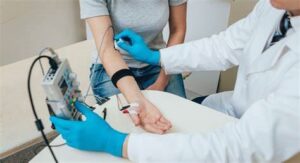NCV / EMG

NCV / EMG
Electromyography (EMG) and nerve conduction velocity (NCV) are electrodiagnostic tests that measure the electrical activity of muscles and nerves. Patients with a spine-related problem may experience unexplained symptoms, numbness and/or tingling sensations, muscle cramping, or weakness in an extremity (e.g. one or both arms, legs). EMG and NCV join forces to help get to the bottom of why those symptoms are occurring.
What to Expect
During an NCV, patch-like electrodes are applied to your skin in several places over the nerve to be tested. Low-level electricity is dispensed through the electrodes to stimulate the nerve. The amount of electricity is similar to a shock from static electricity. The velocity at which the electrical signal flows through the nerve is measured and displayed on a screen.
During an EMG, a thin needle electrode is inserted through your skin into a specific muscle. As you relax and contract the muscle, the electrical impulses are recorded on an oscilloscope, a device that displays the electrical impulses in a wave-like pattern. Additionally, the doctor may listen to the results through a speaker.
- EMG: You may feel discomfort when the needle electrodes are inserted.
- NCV: You may feel startled when the electrical pulses are generated.
- After EMG: The muscle(s) tested may feel sore, and you may have minor bleeding or bruising where the needle electrodes were inserted.
Preparation
- Avoid skin lotion or cream on the areas to be tested
- Please advise our staff if you have a pacemaker. In most cases, exam cannot be performed under this circumstance.
Exams Performed
- NCV
- EMG
